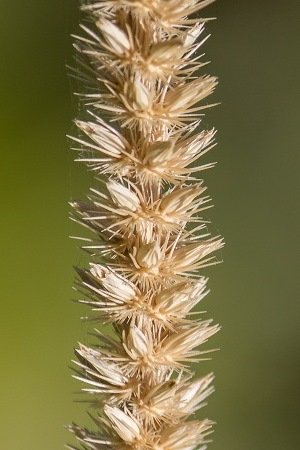Plants of South Florida · Plants by Conservation Area · Plants by County · Plants by Habitat Quick Search · Advanced Search |
||
|
|
||
 |
Cenchrus myosuroides Kunth Big sandbur |
|
|
South Florida Status: Critically imperiled. One occurrence at Dry Tortugas National Park. Taxonomy: Monocotyledon; Poaceae. Habit: Perennial terrestrial herb. Distribution: Native to Florida, the West Indies, Texas, Mexico, Central America, and South America. South Florida Distribution: Lee, Collier and Monroe counties. South Florida Habitats: Shell mounds, coastal berms, dunes, and disturbed areas. Protection Status: Not listed by any agency. Aids to Identification: Hitchcock & Chase (1950) has an illustration. References: Chapman, 1883; Chase, 1920; Small, 1933a; Hitchcock & Chase, 1950; Delisle, 1963; Long & Lakela, 1976; Hall, 1978; Correll & Correll, 1982; Wunderlin, 1998; Liogier & Martorell, 2000. Synonyms: None. Historical Context: John Loomis Blodgett first collected big sandbur between 1838 and 1853 on the island of Key West. Allan H. Curtiss made the next collection prior to 1896 on Indian Key (3620, ISC, US), in what is now Indian Key Historic State Park. Curtiss collected it again on Indian Key in 1896 (5643, ISC, MO, US), and John Kunkel Small and Nathaniel L. Britton collected it there in 1919 (9347, NY). John Kunkel Small and others collected it on West Summerland Key in 1911 (3629, NY). It was observed there again by George N. Avery in 1966 (Avery’s Notes, 12 February 1966), and vouchered again by John Popenoe in 1981 (1950, USF). F.R. Fosberg made a collection on Loggerhead Key in Dry Tortugas National Park in 1962 (43041, US). Reimus and Robertson (1997) reported that it has been observed south of the lighthouse on that key since 1962. Richard E. Reimus reports that he observed perhaps 10-15 plants on Loggerhead Key in March 2001 (personal communication, March 12, 2001). There are also a few collections of big sandbur from the middle and upper Keys. Percy Jones made a collection “South of Upper Matecumbe Key” in 1898 (985, US). This collection was made on railroad and road fill, and may not have represented a native population. Agnes Chase made a collection on Key Largo in 1907 (3936, US), in an “open hammock near Planter.” This may have been in the vicinity of what is now Dove Creek Hammocks, Florida Keys Wildlife and Environmental Area, near the southern end of Key Largo. Jason R. Swallen made a collection on “Key Vacca (Grassy Key)” in 1935 (5201, US), presumably in the vicinity of what is now Curry Hammock State Park. George N. Avery observed it once at Boot Key south of Marathon 1964 (Avery’s Notes, 7 August 1964). In 1980, R.W. Pohl made a collection on dunes on the Atlantic side of 20th Street on “Key Vaca” (13901, ISC). This collection was probably made on Boot Key. Additional collections and reports have been made for islands in Florida Bay, in what is now Everglades National Park. Alvah A. Eaton made the first collection on Joe Kemps Key in 1905 (1345, US). William B. Robertson collected it on Frank Key, just south of Joe Kemps Key, in 1968 (s.n., FTG). Abram P. Garber collected big sandbur at “Caloosa” in 1878 (11906, MO), presumably in what is now coastal Lee County. It also was collected on Marco Island in coastal Collier County. Joseph H. Simpson made the first collection there in 1891 (281, US). Subsequent collections were made by Harold N. Moldenke in 1930 (s.n., FTG) and Olga Lakela in 1962 (s.n., USF; 29070, USF; 29086, USF; 29243, USF). Major Threats: Exotic pest plant invasions; sea-level rise. Comments: Wunderlin (1998) lists big sandbur only for Collier and Monroe counties. There is a specimen collected by Robert Combs in 1898 at Homosassa in Citrus County (Chase, 1920), where it is apparently extirpated. J. Richard Abbott also collected it in Levy County in 1996 (9518, FLAS). This is a perennial species that rarely produces inflorescences in its first year (Delisle, 1963). Recommendations: • Survey Curry Hammock State Park, West Summerland Key and islands in Florida Bay in Everglades National Park, and Tigertail Beach County Park on Marco Island. • Map and monitor known stations on a regular basis. • Conduct conservation biology and conservation horticulture studies. • Consider establishing an ex situ collection of germplasm. • Consider augmenting population at Dry Tortugas National Park. • Consider reintroducing big sandbur to other sites within its historical range, including Indian Key Historic State Park. • Review for listing by FDACS and FNAI. |
||



